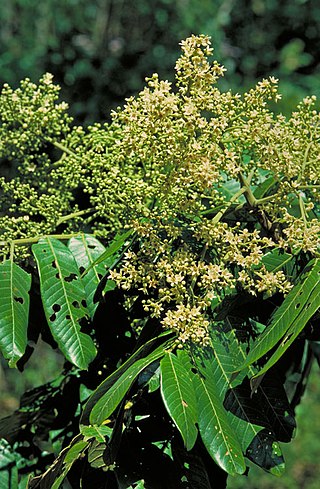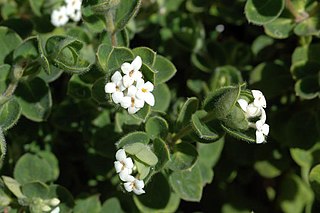
Flindersia schottiana, commonly known as bumpy ash, cudgerie or silver ash, is a species of rainforest tree in the family Rutaceae and is native to New Guinea and eastern Australia. It has pinnate leaves with mostly ten to sixteen leaflets, panicles of white flowers and woody fruit studded with rough points.

Phaleria clerodendron, commonly known as scented daphne, scented phaleria or rosy apple, is an evergreen tree or tall shrub in the family Thymelaeaceae. It is endemic to the rainforests of north-eastern Queensland, Australia.

Argophyllum is a genus in the Argophyllaceae family comprising eighteen species of shrubs and small trees. They feature alternate, simple leaves, often silvery white underneath. They appear in Australia and New Caledonia, where several species are nickel hyperaccumulators.

Carnarvonia araliifolia, commonly known as the red oak, red silky oak, Caledonian oak or elephant's foot, is the sole species in the monotypic genus Carnarvonia, a member of the Proteaceae plant family. It is endemic to the rainforests of northeastern Queensland.

Toechima daemelianum, commonly known as cape tamarind, is an evergreen tree from north-east Queensland in Australia. It grows up to 13 metres high and a trunk which may be up to 20 cm wide.

Bosistoa pentacocca, commonly known as ferny-leaf bosistoa, native almond or union nut, is a species of tree that is endemic to eastern Australia. It has pinnate leaves arranged in opposite pairs with between three and thirteen leaflets and panicles of small flowers arranged in leaf axils or on the ends of branches. It grows along streams in rainforest.

Melicope bonwickii, commonly known as the yellow evodia or yellow corkwood, is a species of tree in the family Rutaceae and is native to Java and the Philippines, and southward to New Guinea and north-eastern Australia. It has trifoliate leaves and small pink flowers borne in panicles in leaf axils.

Cassinia subtropica, commonly known as bushy rosemary, is a species of flowering plant in the family Asteraceae and is endemic to north-eastern Australia. It is shrub with woolly-hairy stems, lance-shaped to egg-shaped leaves and panicles of flower heads.

Atractocarpus hirtus, commonly known as the hairy gardenia or native loquat, is a plant in the madder family Rubiaceae, a large family of some 6,500 species with a cosmopolitan distribution. This species is endemic to northeastern Queensland, Australia.

Argophyllum curtum is a plant in the Argophyllaceae family endemic to a small part of north eastern Queensland. It was described and named in 2018.

Argophyllum palumense is a plant in the Argophyllaceae family endemic to a small part of north eastern Queensland. It was described and named in 2018.
Argophyllum loxotrichum is a plant in the Argophyllaceae family endemic to a small part of north eastern Queensland. It was described and named in 2018.
Argophyllum ferrugineum is a plant in the Argophyllaceae family endemic to a small part of north eastern Queensland. It was described and named in 2018.
Argophyllum heterodontum is a plant in the Argophyllaceae family endemic to a small part of north eastern Queensland. It was described and named in 2018.
Argophyllum iridescens is a plant in the Argophyllaceae family endemic to a small part of north eastern Queensland. It was described and named in 2018.

Pimelea altior is a species of flowering plant in the family Thymelaeaceae and is endemic to eastern Australia. It is a shrub with elliptic leaves and heads of white, tube-shaped flowers.

Archidendron vaillantii, commonly known as the salmon bean, is an evergreen tree in the legume family Fabaceae. It is endemic to the rainforests of northeast Queensland.

Benstonea monticola, commonly known as scrub breadfruit or urchin-fruited pandan, is a plant in the family Pandanaceae which is endemic to rainforested parts of north east Queensland, Australia.

Diploglottis diphyllostegia, commonly known as the northern tamarind, native tamarind or wild tamarind, is a tree in the lychee family Sapindaceae which is endemic to Queensland, Australia. It is an attractive tree with potential in cultivation, with a dense crown of dark green leaves and masses of fruit in spring and summer.

Argophyllum cryptophlebum is a plant in the Argophyllaceae family endemic to a small part of north eastern Queensland. It was described and named in 1907.















